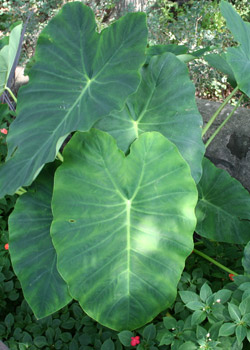Elephant Ears Information

Towering over other plants in the summer landscape, the elephant ear is a wonder to behold! The large leaves of some varieties can reach up to two feet across and three feet long, with stems topping out at eight feet tall! Adding a true taste of the tropics to full sun areas, elephant ears come in a variety of sizes and colors.
Elephant ears do best in hot and bright areas, looking great as a backdrop to a cutting garden or along a pool. Their sturdy stems and lush nature also make them great choices for outdoor as well as indoor containers. The bulbs themselves are quite large and can make a great project for a young child to plant and watch grow!
Plant Information
- Planting Time: Spring
- Bloom Time: Late Summer
- Hardiness Zone: 8-11
- Suitable Zone: 4-11
- Light Needs: Full Sun
Planting Elephant Ears
- Elephant Ear bulbs are typically planted during the spring season once the threat of frost has passed.
- Choose a planting location that has well-drained soil and receives as much direct sunlight as possible.
- Depending on the variety and size of the bulbs, space the elephant ears 24-48"apart (refer to specific variety instructions).
- It is sometimes difficult to determine which end of an elephant ear bulb is the "pointed end." When looking at the bulb, you will most likely notice one end is somewhat gnarly with small holes and divots. This is the end that will produce roots and should be planted downward in the soil. The opposite end of the bulb will be much smoother with distinct concentric rings around it. This smooth end will produce the sprout and should be facing up. Plant the bulb so that it is covered with 1-2" of soil.
- Thoroughly soak the area with water once the tubers have been planted. Continue to water regularly throughout the growing season. Fertilize plants once per month if desired with a well-balanced water soluble fertilizer while actively growing.
- Keep in mind that the Elephant Ear plant is native to areas of extreme heat and tropical climates. Therefore, it will require quite a bit of consistent warm weather to begin sprouting. This can mean sometimes taking a period of 6-8 weeks to sprout once the weather begins to warm in more northern climates. Patience may be required before initial growth is visible.
- Allow plants to continue growing up until just before the first frost. This enables them to produce food for next year's growth. If planted in containers, force the bulbs into dormancy by gradually withholding water at this point or move indoors so that it may continue to grow in the warmth.
- Gently dig up the bulb. Cut what is remaining of the plant stalks within 6" of the bulb and gently rinse off the soil. Allow the bulbs to air dry for at least one full day. Place bulbs in a dry paper bag.
- Store the bags for winter in a dry place which remains consisting below 55 degrees but do not freeze, such as a cellar, basement, or garage.
- Replant in spring according to the above instructions.